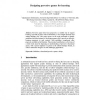Free Online Productivity Tools
i2Speak
i2Symbol
i2OCR
iTex2Img
iWeb2Print
iWeb2Shot
i2Type
iPdf2Split
iPdf2Merge
i2Bopomofo
i2Arabic
i2Style
i2Image
i2PDF
iLatex2Rtf
Sci2ools
114
click to vote
HCI
2011
2011
Designing Pervasive Games for Learning
Pervasive games have been proposed as a suitable way to support learning, especially in places rich in information, as for example museums and cultural heritage sites. This paper reports on the work performed to identify guidelines that help designers in developing games able to provide an effective learning experience in such contexts. Such guidelines complement other proposals available in the literature. The presented contribution is a first step of a wider work aimed at deepening our understanding of pervasive educational games, with a special emphasis on games in the cultural heritage domain, in order to inform the designers of such challenging applications.
Related Content
| Added | 28 Aug 2011 |
| Updated | 28 Aug 2011 |
| Type | Journal |
| Year | 2011 |
| Where | HCI |
| Authors | Carmelo Ardito, Rosa Lanzilotti, Dimitris Raptis, Christos Sintoris, Nikoleta Yiannoutsou, Nikolaos M. Avouris, Maria Francesca Costabile |
Comments (0)

